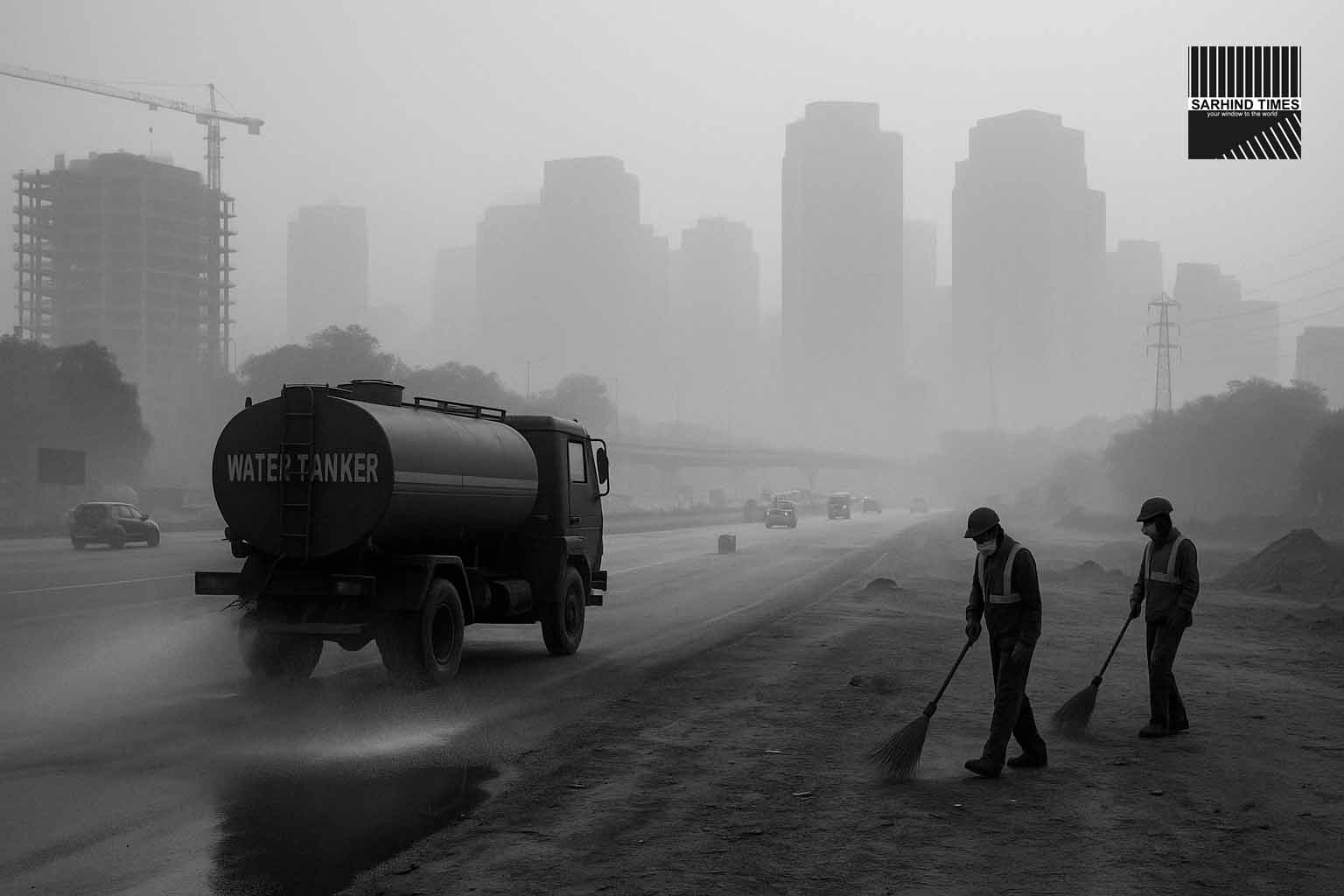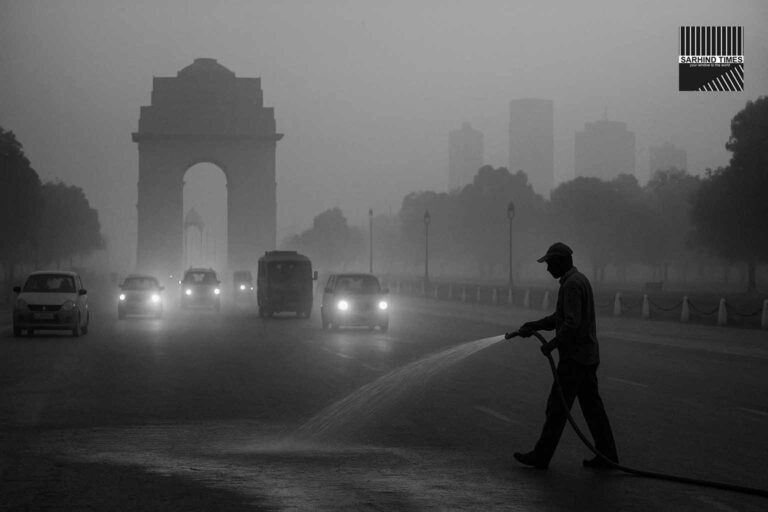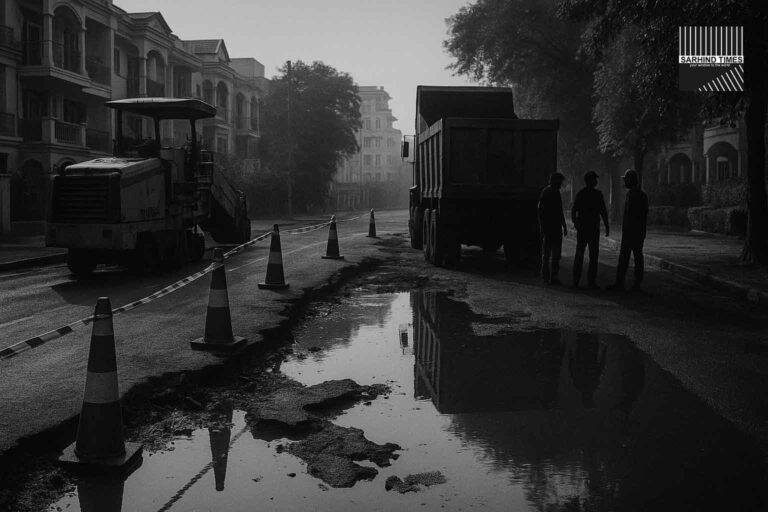By Sarhind Times Bureau | Gurugram | October 15, 2025
Introduction: Gurugram’s Brief Breather Ends
After just two days of respite, Gurugram’s air quality once again dipped into the ‘poor’ category early Wednesday, prompting authorities to re-activate Stage-I of the Graded Response Action Plan (GRAP). According to the Central Pollution Control Board (CPCB), the city’s 24-hour AQI averaged 213, signaling a reversal of gains achieved through recent anti-dust drives and favourable wind conditions.
Civic bodies including the Municipal Corporation of Gurugram (MCG), Haryana State Pollution Control Board (HSPCB), and District Administration have jointly intensified enforcement across the city. The move comes amid rising public concern that Gurugram, once again, is heading into its annual smog season, shadowed by Delhi’s pollution plume and its own construction boom.
Why the Air Turned ‘Poor’ Again
Officials and air-quality experts attribute the sudden decline to a combination of meteorological stagnation and local dust resuspension.
The night before, wind speeds fell below 3 km/h, trapping suspended particulate matter near the surface.
Environmental monitoring stations reported PM2.5 levels averaging 125 µg/m³, more than twice the safe limit prescribed by the World Health Organization.
The pollution sources identified include:
- Construction dust along Golf Course Road, Sohna Road, and the Delhi–Jaipur Expressway flanks.
- Vehicular emissions from peak-hour traffic jams.
- Particulate inflow from Delhi, where GRAP Stage-I had been reactivated a day earlier.
A senior HSPCB official told Sarhind Times:
“The transboundary nature of pollution between Delhi and Gurugram complicates management. The moment wind speeds drop, cumulative emissions from NCR combine and form a haze pocket over the city.”
The GRAP-I Measures: What They Mean for Citizens
The Graded Response Action Plan is a four-stage framework enforced across the National Capital Region (NCR) to curb pollution based on air quality levels.
With AQI between 201–300, Gurugram falls under Stage-I (Poor), triggering the following restrictions:
- Dust control at construction and demolition sites—mandatory use of screens, green covers, and debris management.
- Regular water sprinkling and mechanised road sweeping on major roads.
- Ban on open burning of garbage and leaves.
- Checks on visibly polluting vehicles, including fines and impounding.
- Increased monitoring at stone crushers and ready-mix plants.
- Encouragement of carpooling, public transport, and work-from-home advisories.
Municipal officials said 21 enforcement teams have been deployed across all four zones of Gurugram to monitor compliance, while MCG’s air-quality command centre will track violations in real time.
Voices from the Ground: Residents and RWAs Speak
Residential Welfare Associations (RWAs) across sectors have raised repeated alarms over rising dust levels near construction hotspots.
Sector 56 RWA President, Anil Bhatia, remarked:
“Developers often ignore debris rules despite repeated complaints. We need daily monitoring and mandatory covering of trucks. If Gurugram aspires to be a ‘Millennium City’, it cannot choke its residents.”
RWAs have demanded:
- Public disclosure of violators and penalties,
- Real-time air quality displays in local markets,
- And roadside pollution sensors that can help commuters choose less polluted routes.
These citizen-driven demands echo the broader call for transparency and accountability in environmental governance.
Medical Experts Raise Health Concerns
Health experts are already witnessing an uptick in respiratory and allergy-related cases, particularly among children and senior citizens.
Dr. Reema Malhotra, Pulmonologist at Medanta Hospital, warned:
“Even short-term exposure to PM2.5 can aggravate asthma, bronchitis, and sinus infections. People must avoid peak-hour travel, keep windows shut during evenings, and use air purifiers indoors if possible.”
Doctors also advised residents to carry inhalers and N95 masks, stay hydrated, and limit outdoor workouts during early mornings when particulate concentration peaks.
The Builders’ Responsibility: Compliance Under Scrutiny
Following several warnings, the District Task Force has stepped up surprise inspections at large-scale project sites. Builders have been directed to:
- Install tyre-washing systems at exits,
- Fully cover construction materials with tarpaulin,
- Maintain on-site sprinklers, and
- Ensure zero spillage of debris during transportation.
An MCG enforcement officer said:
“Teams are visiting over 40 active construction sites daily. Any site found non-compliant will face penalties up to ₹5 lakh and work stoppage orders.”
However, environmental activists argue that fines alone are insufficient, urging the state to publicly name defaulters and publish compliance dashboards.
The Larger NCR Context: Shared Sky, Shared Problem
Gurugram’s air crisis mirrors Delhi’s predicament. With the Yamuna plains acting as a pollution corridor, pollutants travel seamlessly across state boundaries.
Experts highlight that pollution cannot be contained by administrative borders. The joint responsibility of Haryana, Delhi, and Uttar Pradesh under the Commission for Air Quality Management (CAQM) becomes critical in this season.
Environmental strategist Ravinder Pahwa explained:
“Unless NCR cities coordinate emission control, one city’s negligence becomes another’s burden. Gurugram’s dust, Delhi’s vehicles, and Faridabad’s industries together form the same air mass.”
Technology and Monitoring: The Missing Link
While Gurugram has multiple monitoring stations, environmental campaigners insist that real-time roadside sensors are still limited.
Citizen groups like ‘Clean Air Gurugram’ have called for installing low-cost sensors across major intersections and linking them to a public mobile dashboard. This would allow commuters to make informed travel decisions and help authorities pinpoint hotspots instantly.
Smart solutions such as AI-based pollution mapping, mobile enforcement cameras, and data-sharing between agencies are being considered by the HSPCB for future integration.
Seasonal Pattern: The Return of the Winter Smog
With October marking the onset of winter, the atmosphere over NCR becomes dense and static, limiting vertical dispersion of pollutants.
Meteorologists from IMD predict:
- Wind speeds below 5 km/h for the next 10 days,
- Rising humidity in evening hours, and
- A gradual dip in temperature to 16°C by late October.
These conditions, combined with stubble burning in northwestern states, create a recurring pollution vortex every year.
Dr. V. N. Dahiya, an environmental scientist, observed:
“This is the start of the inversion season. If local emissions are not curtailed now, AQI levels will spiral to ‘very poor’ or even ‘severe’ by November.”
Public Health Advisory: Protect Before It’s Too Late
Authorities and medical professionals have issued the following guidelines for citizens:
- Avoid outdoor exercise during early morning and late evening hours.
- Keep children and the elderly indoors during peak smog periods.
- Use N95 masks outdoors and air purifiers indoors.
- Maintain indoor plants like Areca palm and Snake plant to improve oxygen levels.
- Opt for public transport or carpooling to reduce vehicular load.
The MCG has also urged citizens to report pollution violations via the ‘Haryana Environment’ mobile app or its official helpline.
Gurugram’s Balancing Act: Growth vs. Environment
Once hailed as a model of urban progress, Gurugram now stands at the crossroads of rapid development and environmental decay.
With thousands of construction projects underway, hundreds of diesel generators, and ever-expanding vehicular density, the city faces the paradox of prosperity—economic rise at the cost of breathable air.
Urban planner Meenakshi Kapoor summarized it aptly:
“Development is essential, but not at the expense of lungs. Gurugram’s future will depend on how it balances infrastructure ambition with ecological restraint.”
Conclusion: A City Holding Its Breath
The reactivation of GRAP Stage-I is both a warning and a wake-up call for Gurugram.
While the authorities scramble to contain visible dust and emissions, the deeper challenge lies in sustaining discipline—among builders, residents, and government bodies alike.
As the winter smog approaches, the city stands united in its shared responsibility: to ensure that the skyline of glass towers does not hide the cost of dirty air.
#Gurugram #AQI #AirPollution #GRAP #CleanAir #Haryana #Environment #SmogAlert #SustainableCity #PublicHealth #NCRPollution #SarhindTimes























+ There are no comments
Add yours